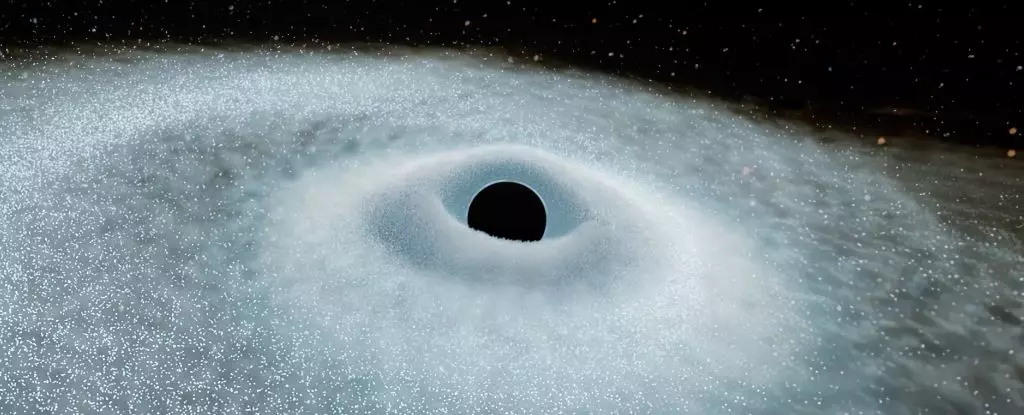In an astounding breakthrough, astronomers utilizing the Gaia space telescope have stumbled upon a new category of cosmic explosions, dubbed Extreme Nuclear Transients (ENTs). These glittering eruptions, the most dazzling since the inception of the cosmos itself during the Big Bang, unveiled their unique characteristics through Gaia’s precise mapping capabilities. The research highlights not merely a new phenomenon but a revolutionary approach in the understanding of black holes, significantly enhancing astrophysics’ comprehension of cosmic evolution.
The energy released by these ENTs is staggering, equivalent to that produced by one hundred Suns over their collective lifetimes. These observations alter the established narrative concerning our universe’s most cataclysmic events. Past models had primarily focused on tidal disruption events (TDEs) where stars succumb to the gravitational forces of supermassive black holes (SMBHs). However, ENTs showcase an intensity and longevity that eclipses traditional understanding, surfacing as an astronomical marvel that invites closer scrutiny.
What Are Extreme Nuclear Transients?
Extreme Nuclear Transients represent a drastic evolution of existing TDE research. Typically, when a star ventures too close to an SMBH, it can be torn apart, producing a burst of light detectable vast distances away. This transformation, often described as a star’s death knell, usually generates a quick flare, a sudden brightening that fades over weeks or months. However, ENTs stand out by exhibiting brightness nearly ten times greater than conventional TDEs, with their light remaining vibrant for years.
Astrophysicist Jason Hinkle from the University of Hawai’i’s Institute for Astronomy describes ENTs as fireballs distinguishing themselves not only through sheer light output but also by their enduring visibility. This extended flare duration poses tantalizing implications regarding how black holes interact with their galactic surroundings, leading researchers to explore what fuels these powerful displays.
Gaia’s Accidental Revelation
The Gaia mission’s original purpose was to map the contours of our galaxy, but it has evolved into an unexpected beacon for uncovering cosmic extremes. In analyzing its extensive data, Hinkle and his team identified two peculiar events, Gaia16aaw and Gaia18cdj, which echoed an astonishing similarity to another event termed “Scary Barbie.” The moniker amusingly reflects the dramatic characteristics of the explosion that sent shockwaves through the astronomical community.
What makes the findings so compelling is the decisiveness with which the researchers debunked the notion of supernova explosions as the source of this exceptional brightness. Unlike supernovae, with their known brightness limits and ephemeral nature, ENTs operate on a scale previously uncharted, effectively reshaping the existing paradigms regarding stellar and black hole interactions.
A Deep Dive into the Dynamics of TDEs
To appreciate how ENTs fit into the broader cosmic puzzle, it’s crucial to understand the mechanics of TDEs. When a star approaches a black hole, the gravitational pull becomes prominent enough to exceed the star’s structural integrity. The result is a cataclysmic event that sends shockwaves of radiation and visible light into space, laying the groundwork for our observations. What sets ENTs apart is not just their extraordinary brightness but also their prolonged emission, suggesting that additional processes could be at play.
Research indicates that every ENT could act as a cosmic marker, guiding astronomers in deciphering how supermassive black holes gain mass over time. These ENTs provide a unique observational opportunity to study black hole behavior in a universe that is notoriously difficult to gauge, especially when it comes to distant and massive celestial entities.
Implications for Astrophysics and Cosmology
The implications of understanding ENTs stretch beyond just identifying new cosmic phenomena. They enable scientists to probe deeper into the lifecycle of galaxies and the evolution of their dominant structures—supermassive black holes. Given that these ENTs are around ten million times rarer than supernovae, their distinctiveness adds layers to the broader understanding of cosmic incidence.
Astrophysicist Benjamin Shappee emphasizes the incredible value of ENTs, stating that their luminosity allows for extensive observations across immense cosmic distances. This capacity to look back in time promotes a deeper understanding of the universe’s behavior in its earliest stages, further bridging the gap between today’s theories and the unknown cosmic past.
The unveiling of Extreme Nuclear Transients not only stirs excitement within the scientific community but also sparks curiosity regarding what lies beyond conventional wisdom. As researchers continue to investigate these flares’ properties, the cosmic tapestry unfolds, shimmered by the brilliance of newfound discoveries, pushing the boundaries of how humanity perceives its place in the vast universe.

